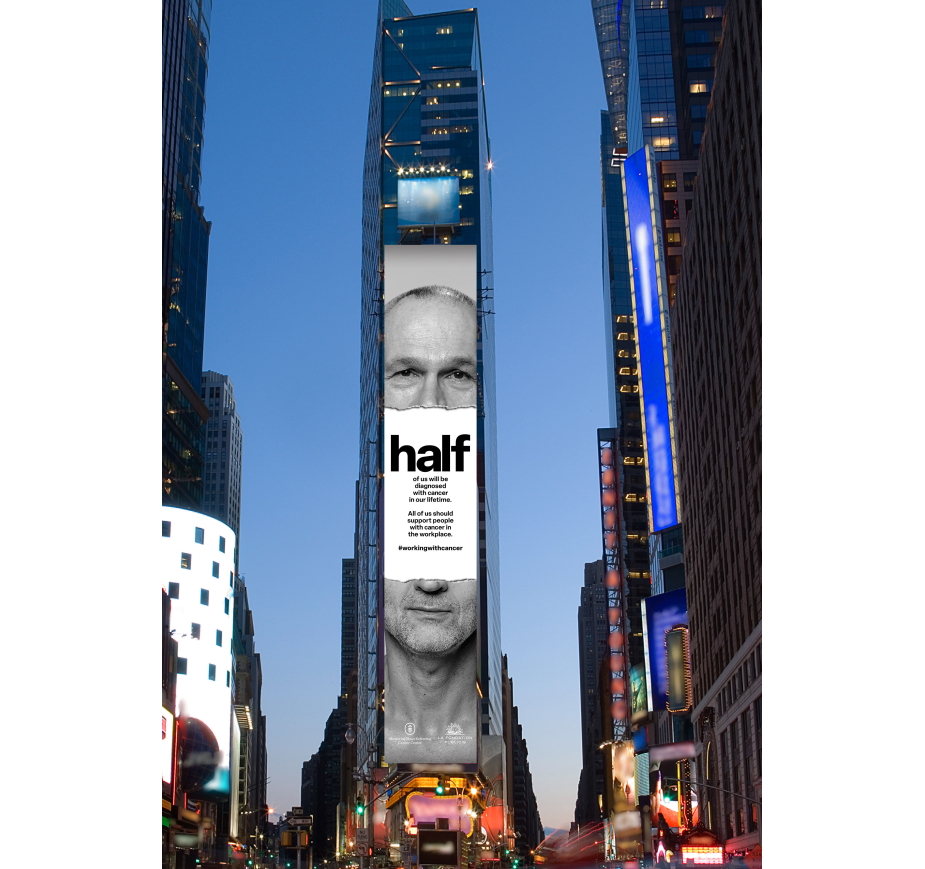
How Publicis Groupe’s ‘Working with Cancer’ Campaign Is Showing Up OOH across the US and Canada

At the World Economic Forum in Davos, on January 17th, Publicis Groupe announced the launch of 'Working with Cancer', a cross-industry coalition to erase the stigma and insecurity of cancer at work.
After being diagnosed and treated for cancer last year, Publicis Groupe CEO Arthur Sadoun received thousands of emails that exposed the fear cancer sufferers experienced, not only for their lives, but also for their jobs. Those messages reflected an unsettling reality: 50% of cancer patients are afraid to tell their employer about their diagnosis.
Since then, Working with Cancer has set its sights on the wider world through a consumer-led campaign that's backed by $100 million in media, which was donated by partners like Disney/ABC, NBCU, Warner Bros Discovery, Paramount, Fox, Roku, Snap, iHeart, Tiktok, YouTube, NCM, Screenvision, Clear Channel, Lamar, Zeta and Meta.
The campaign's central spot, 'Monday', was directed by Elena Petitti di Roreto and Martin de Thurah, and will appear during this Sunday's Super Bowl in a groundbreaking first for a holding company.
A large-scale out-of-home campaign, created by Publicis Groupe collective Le Truc, is showing up in iconic spots such as New York's Times Square.
To find out more about that element of the initiative, and his general thoughts on working such a moving project, LBB's Addison Capper spoke with Andy Bird, founding partner at Le Truc.
LBB> What is the starting point of this initiative and campaign? When and how did it come to be that Publicis Groupe wanted to do something around cancer in the workplace?
Andy> Last year our global CEO Arthur Sadoun was diagnosed and treated for cancer. After he shared his diagnosis, he received thousands of emails that exposed the fear cancer sufferers experienced, not only for their lives, but also for their jobs. Those messages made it clear just how many people were impacted by cancer and other chronic diseases – whether managing their own diagnosis or acting as a caregiver for a loved one. When we looked deeper into the data around this, we found some sobering statistics: one person out of two will be diagnosed with cancer at some point in their lifetime, and 50% of people diagnosed with cancer are scared to tell their employer. I had no idea - personally - about these stats, and it was really shocking to learn, so we embarked on a creative journey to bring them to the wider public and help people feel more assured about revealing their cancer in the workplace without fear of losing their jobs.
LBB> How was developing this work different (or the same) in terms of the process you take with creating client work/for big brands?
Andy> Not much difference to be honest, as everything was done with the same level of care and discernment as any other campaign we might do. Memorial Sloan Kettering Cancer Center in the US, and Macmillan Cancer Support in the UK were some of our partners on the project, so there were a lot of the normal creative presentations you’d have with any client. And Arthur has an eye for creative, as you can imagine.

LBB> What were the biggest considerations when creating the campaign and how are they reflected in the final production - both for the spot launched at Davos and the OOH work?
Andy> The biggest consideration was just being true and empathetic to the issue. Nearly everyone on the project has been affected by cancer or had family members who have, so it was something we were aware had to be handled with real sensitivity. We wanted to make sure the scenarios in the film really felt authentic - not only in subject, but in emotion.
LBB> Tell me about the OOH work - what were your biggest inspirations in terms of the look and feel?
Andy> We needed to bring the 50% stat in a really simple graphic style. A cancer diagnosis can literally tear your life in half in the workplace and outside, so we felt the dramatic nature of that art direction was merited and made sense.

LBB> Where will the OOH work show up in the world?
Andy> We have Times Square out-of-home placements including ‘One Times Square’ on launch day, January 31st - which is where the ball drops on New Year’s Eve - in addition to mobile billboards and elevator networks across US and Canada.
LBB> The consumer campaign backed with a donated $100 million media budget. What is the aim of the campaign, considering the businesses already supporting Working with Cancer?
Andy> It was important for us to give the campaign some legs beyond the business community and launch the consumer campaign with a media plan to bring more awareness and momentum. The consumer campaign will be supported by $100 million in media donated by our partners, and Publicis Groupe will also contribute with a Super Bowl spot.
LBB> What kind of changes/initiatives do you hope businesses will make to better support employees? And how is Publicis implementing similar actions globally?
Andy> Together with Memorial Sloan Kettering Cancer Center, MacMillan Cancer Support, the Gustave Roussy Institute and other leading cancer orgs, we hope to build a more open, supportive and recovery-forward culture in the workplace. The first phase of our campaign invited companies across the globe to join the movement and outline their own commitments to cancer patients in their organisations. Publicis’ specific pledge is to provide cancer patients with full job security for at least one year, and to provide the necessary career support not only for them, but also for caregivers in our organisation. With this next phase, the consumer campaign, we are driving awareness beyond the corporate level and urging everyone to play their part in supporting colleagues with cancer.
LBB> Any parting thoughts on this?
Andy> A lot of people contacted us (some who I know, and a lot that I don’t) about how this work has touched them in some way. It tells me that this is an invisible problem that has long been overlooked. We still have a lot more work to do.













